|
|
Monday, February 16th, 2009 at 1:21 pm
Well, today I am going to spend the night in the hospital, it seems. Ugh.
I really don’t feel that bad, it’s a procedural thing. My fever went away, then came back a little, and the PCMO (Peace Corps medical officer) said I should go to the hospital, since we were in town anyways, and get checked out. Besides the standard exam stuff, they decided they needed 3 vials of blood, 4 blood smear slides, a urine sample, a stool sample, three head x-rays, and two chest x-rays. It all feels very silly, as I no longer have a fever as of noon. The chest X-ray was especially odd; they took the first one, and the tech came back in and said, “Do you exercise? Your lungs are HUGE, we have to do it again.” Huh. I think they must just be used to zapping tiny Guatemalans instead of “giant” gringoes.
update: 4 Guatemalan nurses just came in, and told me I can’t eat anything until after they ultrasound my stomache at 4pm. WHAT THE HECK???!?!? you’d think I had the black plague, or ebola, or avian flu or something like that. Dude, they don’t have a clue and are just grasping at straws. I am OUT of here tomorrow morning.
Posted by: jfanjoy
Saturday, February 14th, 2009 at 10:17 pm
Ugh, I am sick. It came on kindof suddenly; I got horrible chills and a sleepless night thursday morning that then turned into three days of 102-degree fever with body aches and occasional nausea. This is really only the second time I’ve been sick since we got to Guatemala. The unfortunate part is that we’re on the road; we left Thursday for a meeting with the Health Ministry and our Peace Corps superiors to give a project briefing, and then we continued on to Xela for a get-together to celebrate Anne’s birthday. I participate in the festivities when I can, but sometimes it’s just easier to lay in the next room and moan. Everyone cooked a fancy pitch-in dinner last night, there was lots of merrymaking, but the best I could do was to drag my butt over there and watch. But we don’t get to see Americans very often, so i tried to make the best of it. Right now I am resting in the courtyard/patio of the hostel, while eveyone else is out shopping and enjoying their day. It’s about all I am up for.
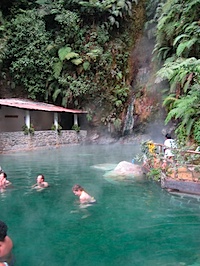 The one bright side of all this is that all 12 of us PCVs went to the Fuentes Georgianas hot springs yesterday. It was way out in the boonies, a jungle-mountain setting that reminded me a lot of Hawaii. The springs themselves are a series of volcanic pools with pretty green steaming waters. Though I felt like hell when we got there, a good hot soak did my body a lot of good. They say the waters are medicinal. There may be some truth to that. The one bright side of all this is that all 12 of us PCVs went to the Fuentes Georgianas hot springs yesterday. It was way out in the boonies, a jungle-mountain setting that reminded me a lot of Hawaii. The springs themselves are a series of volcanic pools with pretty green steaming waters. Though I felt like hell when we got there, a good hot soak did my body a lot of good. They say the waters are medicinal. There may be some truth to that.
The Peace Corps nurse said Emily and I should stay an extra day in Xela, in case I don’t get better. In that case, they will have me visit the approved medical facility here: a lot more sensible than traveling 8 hard hours home, then having to come right back to go to a doctor.
Posted by: jfanjoy
Saturday, February 14th, 2009 at 10:11 pm
Although the feria is an all-week thing, we enjoyed our last day of it on Wednesday. The meeting Thursday with our Peace Corps superiors and the Guatemalan Ministry of Health took place in Huehuetenango, the state capitol, and for us to arrive there on time would be a physical impossibility with the bus schedules unless we spent wednesday night in Santa Eulalia, a thing we rarely do. This turned into a blessing in disguise; firstly because it gave us the chance to take up Pedro’s offer of hospitality that he keeps making. Secondly, because wednesday’s festivities mostly take place in the twilight hours after the busses out to the villages have stopped running.
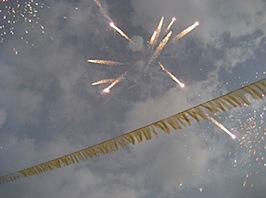 Some of the things that Guatemalans love the most in the whole world, besides The Virgin Mary and tortillas, are bombas (fireworks). Pyrotechnics appear at all festive occasions; for birthdays, a 6-foot chains of firecrackers is mandatory. For more serious occasions like weddings and holy days, they bust out the Big Guns. They have these tubes of steel, about 4 inches across and about two feet high, welded to big iron bases to keep them pointed at the sky. I don’t know what they’re called here, but I would use the word “mortar”. Then they stick this explosive charge into them that looks like a softball with a 3-foot fuse. They light it with a cigarette, and run like hell. The bomba is a two-part charge: the first one goes off with a thunderclap, sending the larger explosive hundreds of feet into the air. An internal fuse causes the second charge to go off about when it reaches apogee (more on that later). Some make bright colors like our Independence Day fireworks, others make enormous bangs and rattle every window in town. Some of the things that Guatemalans love the most in the whole world, besides The Virgin Mary and tortillas, are bombas (fireworks). Pyrotechnics appear at all festive occasions; for birthdays, a 6-foot chains of firecrackers is mandatory. For more serious occasions like weddings and holy days, they bust out the Big Guns. They have these tubes of steel, about 4 inches across and about two feet high, welded to big iron bases to keep them pointed at the sky. I don’t know what they’re called here, but I would use the word “mortar”. Then they stick this explosive charge into them that looks like a softball with a 3-foot fuse. They light it with a cigarette, and run like hell. The bomba is a two-part charge: the first one goes off with a thunderclap, sending the larger explosive hundreds of feet into the air. An internal fuse causes the second charge to go off about when it reaches apogee (more on that later). Some make bright colors like our Independence Day fireworks, others make enormous bangs and rattle every window in town.
So, they fired off a fair amount of those in the town square in front of the church. In UN-typical Guatemala fashion, they made everyone stand at the very edge of the square, giving the demolitions guys room to work. “Yeah, about 8 years ago they shot off one of the big ones, and the second charge didn’t go off right. It hung in the air for a minute or so, fell back in to the crowd, and then went off. Someone got killed, so they don’t let you stand right next to them anymore,” Aurelio later told us. Um, yeah.
As the evening wore on, we got to see one of those monstrosities he mentioned. Two guys came waddling out carring what looked like a concrete-filled truck rim with a man-sized steel tube cast into it. “Oh no,” I remember thinking. Then another guy came out carring a bomba the size of a volleyball, with a 6-foot fuse, and dropped it in. Despite my subconscious urge to flee for my life, I had to see what was going to happen. He lit it with his cigarette, and nothing. He looked annoyed, lit it again, and still nothing. A few more guys came out, they spoke some hushed words, and he puffed on his smoke a few times in rapid succession to get the embers really hot. He touched it to the fuse, and red fire shot out the end. Everyone scattered like roaches on the kitchen floor when the lights come on.
The first explosion was a little disappointing. “Maybe the ratio of the surface area of the tube opening to the launching charge’s explosion is actually lower than the others, lessening the overall velocity of the projectile and escaping gasses, thereby reducing the noise despite the overall increase in imparted energy,” I thought to myself. That thought was interrupted by the second explosion, which knocked over children, small animals, and several of the more poorly-built structures in the central urban area.
Oops, Emily says I have to admit that I lied in that last sentence. But it WAS awfully loud.
 The other great joy we experienced in our final day of the feria was the torito, or “little bull”. They had three of them at the Virgen de Guadalupe festival in our village, so I sortof knew what they are about: it’s a wicker “bull”, maybe more the size and shape of a really big steamer trunk, with a big cardboard box inside. A bull’s face is painted on the front, which is funny to me, because for MOST of them, the bull’s face is the distincitve “Chicago Bulls” logo, blown up big on a photocopier and glued onto the front of the torito. Then, the wicker cage is adorned with all types of fireworks: whistlers, roman candles, bangers, rockets, spinners, you name it, all of which are chained together with a really long fuse. I am ashamed to admit that when they had them in our village, we were too tired the night they lit them off to go see them. As we found out Wednesday, that was a big oversight. The other great joy we experienced in our final day of the feria was the torito, or “little bull”. They had three of them at the Virgen de Guadalupe festival in our village, so I sortof knew what they are about: it’s a wicker “bull”, maybe more the size and shape of a really big steamer trunk, with a big cardboard box inside. A bull’s face is painted on the front, which is funny to me, because for MOST of them, the bull’s face is the distincitve “Chicago Bulls” logo, blown up big on a photocopier and glued onto the front of the torito. Then, the wicker cage is adorned with all types of fireworks: whistlers, roman candles, bangers, rockets, spinners, you name it, all of which are chained together with a really long fuse. I am ashamed to admit that when they had them in our village, we were too tired the night they lit them off to go see them. As we found out Wednesday, that was a big oversight.
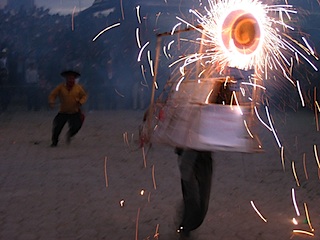 That’s because we made the SILLY assumption that they just set these contraptions on the ground in front of the church and light them. Goodness no, this is Guatemala! There is a dude that climbs inside, another dude that wears a matador costume, and they have a mock bullfight! WHILE THE WHOLE THING IS ON FIRE!!!!!! I never would have believed it, but I have the pictures to prove it. The bull galavants around the town square, fireworks shooting off in random direction, launching into the crowd, setting stuff on fire- HILARIOUS. A bottle rocket shot off of a torito at one point and bounced off of Emily, then started chasing other bystanders around as they screamed and hollered. All the while, the guy inside the bull is jumping and dancing and charging the matador and teasing the crowd, the cardboard “shell” inside protecting him from the worst of the pyrotechincs. Emily said it reminded her of the Catalunyan correfoq, a marching pyrotechnics parade & festival they have in parts of Spain. That’s because we made the SILLY assumption that they just set these contraptions on the ground in front of the church and light them. Goodness no, this is Guatemala! There is a dude that climbs inside, another dude that wears a matador costume, and they have a mock bullfight! WHILE THE WHOLE THING IS ON FIRE!!!!!! I never would have believed it, but I have the pictures to prove it. The bull galavants around the town square, fireworks shooting off in random direction, launching into the crowd, setting stuff on fire- HILARIOUS. A bottle rocket shot off of a torito at one point and bounced off of Emily, then started chasing other bystanders around as they screamed and hollered. All the while, the guy inside the bull is jumping and dancing and charging the matador and teasing the crowd, the cardboard “shell” inside protecting him from the worst of the pyrotechincs. Emily said it reminded her of the Catalunyan correfoq, a marching pyrotechnics parade & festival they have in parts of Spain.
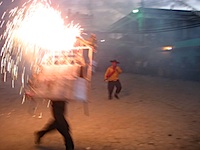 They’d built five toritos, so that part of the festivities took quite a while, and was wholely entertaining. About half way through it, the “bull” slipped on a banana peel (no, I’m serious; the square is a fruit market during the day) and fell over. I felt bad for him for about .4 seconds, then realized that his rocket launchers were now pointing at the crowd instead of the sky. Luckily, he jumped right back up and carried on, before the fuse burned down to where the rockets were. We found out a few days later that the secret guy in the torito was actually our friend Luin, the quiet timid statistician from the health center. Hah! They’d built five toritos, so that part of the festivities took quite a while, and was wholely entertaining. About half way through it, the “bull” slipped on a banana peel (no, I’m serious; the square is a fruit market during the day) and fell over. I felt bad for him for about .4 seconds, then realized that his rocket launchers were now pointing at the crowd instead of the sky. Luckily, he jumped right back up and carried on, before the fuse burned down to where the rockets were. We found out a few days later that the secret guy in the torito was actually our friend Luin, the quiet timid statistician from the health center. Hah!
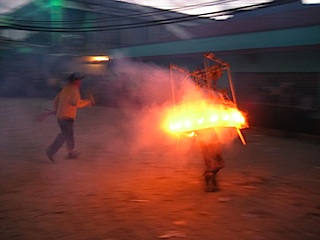 Having seen all this, I feel like we had a good faire. It also helped me to answer one of those gnawing cultural questions that had been bugging me since December. A few days after our village’s Guadalupe celebration, I was chopping wood outside our house and saw the local kids playing in an empty lot next door. They were chasing each other around, giggling and screaming, generally having a good time. Then i noticed that two of the kids were running around with a big cardboard box over their heads. It was on fire. Having seen all this, I feel like we had a good faire. It also helped me to answer one of those gnawing cultural questions that had been bugging me since December. A few days after our village’s Guadalupe celebration, I was chopping wood outside our house and saw the local kids playing in an empty lot next door. They were chasing each other around, giggling and screaming, generally having a good time. Then i noticed that two of the kids were running around with a big cardboard box over their heads. It was on fire.
My initial distress faded as I remembered seeing these same kids play with rusty machetes, used syringes, and rabid dogs. What’s a flaming box? So I went inside, reported the incident to Emily, and went back to chopping. Now, as Paul Harvey says, “I know the rest of the story”.
Note: I took a GREAT video of the toritos as well. Maybe if I find a fast connection, I can upload it.
Posted by: jfanjoy
Wednesday, February 11th, 2009 at 12:52 pm
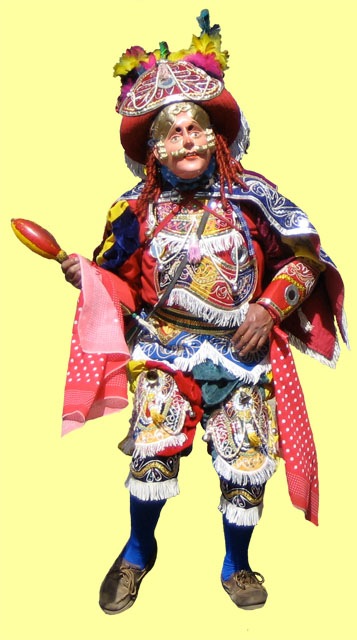 The feria, or county fair, rages on. It’s a week-long festival of parades, traditional dancing, horse trading, cotton-candy eating, Ferris wheel riding, drinking, and socializing. Not necessarily in that order. The feria, or county fair, rages on. It’s a week-long festival of parades, traditional dancing, horse trading, cotton-candy eating, Ferris wheel riding, drinking, and socializing. Not necessarily in that order.
This fellow on the left is one of many “conquistador dancers” that perform during the feria. The Maya have a long memory; this dance commemorates the Spanish conquests in the early 1500s, when European men with horses and guns showed up to massacre and enslave the natives here. The costuming is a fascinating social commentary on how one culture views another: the conquistadores are white-faced, fair-haired men with bright, colorful, clean clothes. Their outfits are opulently adorned, and you can still see the echoes of medieval Europe in their styling. Mirrors adorn their arms, legs, and capes, and we’ve heard several stories about the mirrors’ origin: one says they make the dancers more “brilliant”. Another explains that the mirrors are symbolic of the trickery and technology that the conquistadores used to defeat the Maya in battle after battle. A final tale is that the Maya, having never seen a mirror before, were so enthralled by its magic that they were regularly duped into trading gold for mirrors during the early days of the conquest.
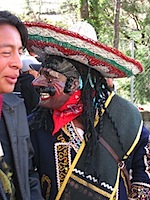 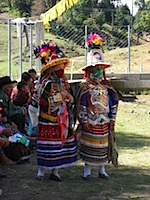
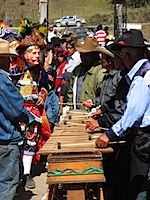 The concept of “conquistadores” has evolved somewhat in the intervening centuries, though. There is usually a negrito present, as well as one or two children dancers. I really couldn’t get a good explanation of their presence; instead I was told that the dancers are selected the year before, and spend the intervening time practicing the routines. The guys that play the marimba for this special dance have been doing it their whole lives, know everything by heart, and apparently only get replaced when they die (like the Supreme Court justices). Regardless of how you look at it, it’s a bit awkward as a white person to watch this tribute to a pretty dark period in history. The concept of “conquistadores” has evolved somewhat in the intervening centuries, though. There is usually a negrito present, as well as one or two children dancers. I really couldn’t get a good explanation of their presence; instead I was told that the dancers are selected the year before, and spend the intervening time practicing the routines. The guys that play the marimba for this special dance have been doing it their whole lives, know everything by heart, and apparently only get replaced when they die (like the Supreme Court justices). Regardless of how you look at it, it’s a bit awkward as a white person to watch this tribute to a pretty dark period in history.
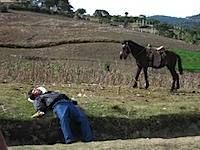 As will happen here, some take the festival as a chance to drink too much. We see a lot more bolos (drunks) during this time than normal. I will spare you most of it, but some of the sights are such an odd combination of sad yet funny that I have to share them. This one is titled, “I like corn.” Click it to enlarge. As will happen here, some take the festival as a chance to drink too much. We see a lot more bolos (drunks) during this time than normal. I will spare you most of it, but some of the sights are such an odd combination of sad yet funny that I have to share them. This one is titled, “I like corn.” Click it to enlarge.
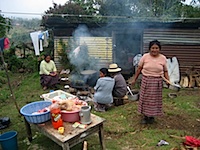 The feria is also when people throw their own parties. Here is a party we went to at Pedro’s house. They killed a pig, so they invited us. If you zoom in, you can check out the pig head and guts still on the picnic table in front of us, right along with the soda pop and napkins. Sweet. I wore my capishay to these various festivities, in part becuase it is cold, but also because it’s a big hit with the locals. I was asked to take a picture with Pedro’s nephew, as he has a miniature one, too! The feria is also when people throw their own parties. Here is a party we went to at Pedro’s house. They killed a pig, so they invited us. If you zoom in, you can check out the pig head and guts still on the picnic table in front of us, right along with the soda pop and napkins. Sweet. I wore my capishay to these various festivities, in part becuase it is cold, but also because it’s a big hit with the locals. I was asked to take a picture with Pedro’s nephew, as he has a miniature one, too!
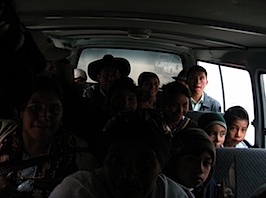 < < Pedro lives in the main town, so after his party, we got a ride back to our village in a pretty full microbus. Emily got right in there and snagged the front seat. Thank goodness. Once about half the people cleared out (we’re the last stop), we looked back to discover that Nas Palas and most of his family were in the back. I guess they were enjoying some time at the feria too! It’s a dark picture, but we can see (left to right): Nas, Lina, Lucia, Rigo, Alberto, and Chalio. I think Hela was in there as well somewhere, and maybe more. Pedro lives in the main town, so after his party, we got a ride back to our village in a pretty full microbus. Emily got right in there and snagged the front seat. Thank goodness. Once about half the people cleared out (we’re the last stop), we looked back to discover that Nas Palas and most of his family were in the back. I guess they were enjoying some time at the feria too! It’s a dark picture, but we can see (left to right): Nas, Lina, Lucia, Rigo, Alberto, and Chalio. I think Hela was in there as well somewhere, and maybe more.
Posted by: jfanjoy
Tuesday, February 10th, 2009 at 11:28 pm
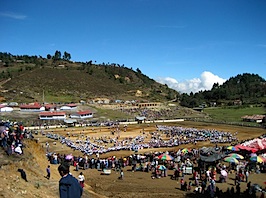 This week is the Santa Eulalia feria, a celebration of the saint’s day for the town’s namesake. No one works except the guys that sell street food, knicknacks, balloons, and things you can’t normally get in our market. Needless to say, we aren’t giving any lectures or training or having any meetings, because no one would show up! We don’t really get the whole week off, though; we’re busy planning and corresponding with people trying to set up projects, and we have to do a presentation to our bosses in the capitol on Thursday to explain what we’re up to. But despite that, there’s plenty of time to go to the feria and mingle with the locals, learning about their culture and getting them more used to seeing us. In fact, today I had a typical exchange I want to share with you: This week is the Santa Eulalia feria, a celebration of the saint’s day for the town’s namesake. No one works except the guys that sell street food, knicknacks, balloons, and things you can’t normally get in our market. Needless to say, we aren’t giving any lectures or training or having any meetings, because no one would show up! We don’t really get the whole week off, though; we’re busy planning and corresponding with people trying to set up projects, and we have to do a presentation to our bosses in the capitol on Thursday to explain what we’re up to. But despite that, there’s plenty of time to go to the feria and mingle with the locals, learning about their culture and getting them more used to seeing us. In fact, today I had a typical exchange I want to share with you:
“Welcome to Guatemala!” says a guy with a tent selling fancy shoes, as he checks out my Gringo looks.
“Gracias,” I reply. “De donde eres?” (Thanks. Where are you from?)
“Soy de Xela,” he replies, looking a little confused. (He’s from Xela, a big city about 6 hours south of here. A lot of these guys travel from feria to feria, selling specialty items.)
“Muy Bien!” I reply, shaking his hand and patting him on the shoulder. “Entonces, bienvenidos a Santa Eulalia! Soy de Temux Grande, una aldea de aqui.” (I just told him that I actually live here, and I should be welcoming him to my town instead of the other way around.)
At this point, much hilarity ensues. It blows them away that ANY gringo would live here for two years, and they dig it. In most cases, the person is from the surrounding region, and speaks Q’anjob’al. This is when I bust out a few phrases in the local dialect, and I have a new friend forever. Then, they talk about their time in the US, or their kids, or my lack of kids, or whatever. You get the picture.
Anyways, we were watching the parade today, when the guy in front of me started chatting in a similar manner. This is pretty normal, and would freak me out as I am normally a pretty introverted person, but I got this thing from my Dad where when Joe Plumber wants to talk to me, I can just talk like I’ve known the guy for years. This comes in handy all the time in Guatemala. In this case, I ended up meeting Lorenzo Mateo. He’s been to the US, and speaks reasonably good English. He is interested in practicing with us, as there is little opportunity to practice in Santa Eulalia because everyone who goes to the US ends up learning Spanish there while working on Mexican crews, and never learns English. But he went to school for a bit. He mentions the idea of helping us learn Q’anjob’al as well, which we are interested in, but we need someone who can also write it. “No problem,” says he. Turns out, he’s a member of the Mayan Language Academy, and he’s got the goods on written Q’anjob’al.
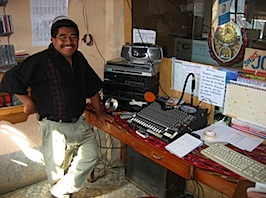 But that’s not all, he’s also on the board of directors of Snoq’ Jolom Konob’, the town radio station. “Come with me to the station, I will show it to you,” he says. We follow him a half block to the radio station (we’d seen it before and knew where it was) and he took us inside and showed us around, speaking English all the way. They were playing marimba music at the time (of course) and he dimmed the volume down and starting talking into the big fuzzy microphone in Q’anjob’al. I could follow about 10% of what he was saying, things about the feria and such, then he mentioned that there were some gringoes that lived in town and work with the health center, and they were with him in the studio. Then he looked at me, and moved away from the microphone. But that’s not all, he’s also on the board of directors of Snoq’ Jolom Konob’, the town radio station. “Come with me to the station, I will show it to you,” he says. We follow him a half block to the radio station (we’d seen it before and knew where it was) and he took us inside and showed us around, speaking English all the way. They were playing marimba music at the time (of course) and he dimmed the volume down and starting talking into the big fuzzy microphone in Q’anjob’al. I could follow about 10% of what he was saying, things about the feria and such, then he mentioned that there were some gringoes that lived in town and work with the health center, and they were with him in the studio. Then he looked at me, and moved away from the microphone.
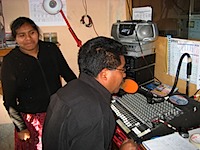 UM, YEAH. The joke’s on me. “Trajein ayeq hemasanil,” I said into the microphone, spending most of my Q’anjob’al in one pass. Then I spoke a few minutes in Spanish about how nice the fair was and how happy everyone looked and how much fun we were having. Luckily, at that point I was able to give the microphone to Emily, and she said some intelligent sounding stuff to balance out my vapid commentary. Having done that, we exchanged phone numbers with Lorenzo so we can visit again sometime. He has a radio program weekly on Saturday night and he’s invited us to join him. I think I’m into that. UM, YEAH. The joke’s on me. “Trajein ayeq hemasanil,” I said into the microphone, spending most of my Q’anjob’al in one pass. Then I spoke a few minutes in Spanish about how nice the fair was and how happy everyone looked and how much fun we were having. Luckily, at that point I was able to give the microphone to Emily, and she said some intelligent sounding stuff to balance out my vapid commentary. Having done that, we exchanged phone numbers with Lorenzo so we can visit again sometime. He has a radio program weekly on Saturday night and he’s invited us to join him. I think I’m into that.
More on the feria itself in the next post.
Posted by: jfanjoy
Monday, February 9th, 2009 at 9:41 am
My friend Jerry Hoffman once told me, “People that spend a lot of money on toys for their kids are pretty dumb, because kids are simpler than that. If you buy them a really fancy toy, they have as much fun playing with the box it came in.” I mentioned that to my mom, and she said I was even more so- I would often spend MORE time playing with the box.
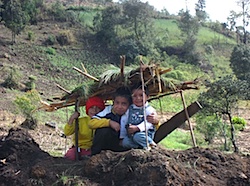 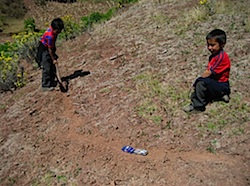 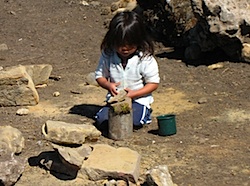
I think about this a lot in Guatemala. Here, the kids seem just as happy as any kids I’ve worked with in the US, but they prettymuch have nothing. This isn’t a message of “oh, pity the Mayan kids,” I just think it’s an interesting social observation. Maybe we give our kids too much? I have several friends who have a room FULL of toys for their kids (literally), and in some cases have so many toys that they need to take them in and out of circulation, hiding some in the attic just to keep the mess under control. Mayan parents every now and then give their kids a plastic car from the market, but in general kids just play with whatever is laying around. They build houses out of sticks, like this one Chalio made. They use a pickaxe to dig a racetrack in the cornfield. They make a kitchen out of rocks. They go walking in the hills and fields, catching dragonflies and splashing in creeks. They roll around and wrestle with their dogs. It kindof reminds me of an idealized frontier-days America.
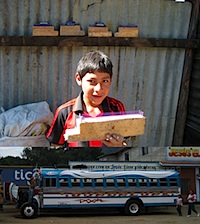 Some kids that DO want toys realize they have to take it upon themselves. I was walking by a construction site, and saw this kid making toy camionetas (busses) from scrap wood and nails during his break. He even put some spare batteries in the luggage rack on top, as suitcases. I asked him if he was making them to sell, and he looked baffled. Nope, just making them for the hell of it. I saw some different kids playing with two of his camionetas a week later. Santa Claus Junior, I guess. Some kids that DO want toys realize they have to take it upon themselves. I was walking by a construction site, and saw this kid making toy camionetas (busses) from scrap wood and nails during his break. He even put some spare batteries in the luggage rack on top, as suitcases. I asked him if he was making them to sell, and he looked baffled. Nope, just making them for the hell of it. I saw some different kids playing with two of his camionetas a week later. Santa Claus Junior, I guess.
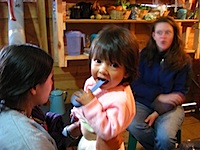 Of course, if they are too young to make toys, they convert other things. Delmi likes to come to our house to play with our measuring cups and dishes. We have more of these things than most of our neighbors put together, though we have about a tenth of what we had in the US. And when they all want to play with the same toy? They share, even to the point of being rediculous. The neighbor kids have this old, beat-up plastic horse with wheels instead of feet. It’s about 18 inches tall, barely big enough for a toddler to ride. But everyone LOVES it, and it get so much use it’s falling apart. Or maybe it’s falling apart because of HOW they sometimes share it: here we see three kids riding it at once, while a fourth looks on. Hilarious. Of course, if they are too young to make toys, they convert other things. Delmi likes to come to our house to play with our measuring cups and dishes. We have more of these things than most of our neighbors put together, though we have about a tenth of what we had in the US. And when they all want to play with the same toy? They share, even to the point of being rediculous. The neighbor kids have this old, beat-up plastic horse with wheels instead of feet. It’s about 18 inches tall, barely big enough for a toddler to ride. But everyone LOVES it, and it get so much use it’s falling apart. Or maybe it’s falling apart because of HOW they sometimes share it: here we see three kids riding it at once, while a fourth looks on. Hilarious.
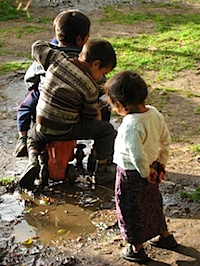 Of course, there is a darker side of this. Because their culture is not a “things” culture, they don’t respect personal property, privacy, or ownership. The things they DO have are in ratty condition because they don’t take care of their stuff. I first thought this was a poverty issue, and in some cases it is, but I’ve seen kids break a toy by accident and just throw it in the bushes, as though nothing happened. The toy is instantly gone from memory. It’s not until they are adults that they clean things, maintain them, repair them… but even then, things of quality and workmanship are rare and undervalued. Of course, there is a darker side of this. Because their culture is not a “things” culture, they don’t respect personal property, privacy, or ownership. The things they DO have are in ratty condition because they don’t take care of their stuff. I first thought this was a poverty issue, and in some cases it is, but I’ve seen kids break a toy by accident and just throw it in the bushes, as though nothing happened. The toy is instantly gone from memory. It’s not until they are adults that they clean things, maintain them, repair them… but even then, things of quality and workmanship are rare and undervalued.
Posted by: jfanjoy
Saturday, February 7th, 2009 at 5:43 pm
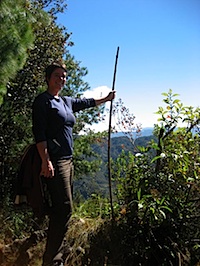 Today we said goodbye to Elke Richer, the intern from StoveTeam that has been hanging out with us for a week. She’s the first gringo to ever visit us in our site, and there probably won’t be many more- let’s face it, the trip out here is TOUGH, and there’s not much to see once you get here except Mayan culture and amazing countryside. Even Elke agreed, the trip was even harder than she’d imagined, and she’s done this kind of traveling before. She was so worn out after the journey here that she spent all afternoon sleeping. Today we said goodbye to Elke Richer, the intern from StoveTeam that has been hanging out with us for a week. She’s the first gringo to ever visit us in our site, and there probably won’t be many more- let’s face it, the trip out here is TOUGH, and there’s not much to see once you get here except Mayan culture and amazing countryside. Even Elke agreed, the trip was even harder than she’d imagined, and she’s done this kind of traveling before. She was so worn out after the journey here that she spent all afternoon sleeping.
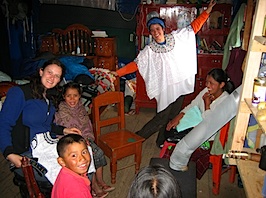 It’s interesting to me how your life in Peace Corps can’t help but mimic your ordinary life. In the US, Emily & I rarely had visitors* because all of our friends are busy and we live too far away to be convenient. But since we like to travel, it’s sortof our lot to be the people who do the visiting. I guess that’s made us appreciate guests that much more. It’s interesting to me how your life in Peace Corps can’t help but mimic your ordinary life. In the US, Emily & I rarely had visitors* because all of our friends are busy and we live too far away to be convenient. But since we like to travel, it’s sortof our lot to be the people who do the visiting. I guess that’s made us appreciate guests that much more.
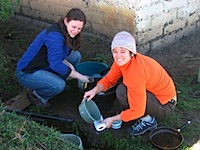 We loved having Elke, and having the opportunity to play host. We took her on a few hikes to show her the beauty of this place, and we introduced her to a few local families so she could get a feel for how the Maya live in these parts. She got along fabulously with our neighbors; that was helped because she speaks Spanish well and half of her family is Mexican, so she’s famililar with some of the cultural norms. We also shared some of the mundane parts of Peace Corps life with her, like washing the dishes in the river and bathing in the chuj. She was a pretty good sport about all of it, and even took a few turns fixing meals. The only thing that seemed to slow her down in the slightest was the cold: no one ever comes to Guatemala expecting to freeze their butt off, and this week’s been especially nasty: 30+ mph winds, and cold enough that there was a quarter-inch of ice on the corn stubble in the fields this morning. To be honest, I was pretty impressed with her; it takes a lot of guts to travel around in a foreign country, alone, in the far reaches of civilization. We loved having Elke, and having the opportunity to play host. We took her on a few hikes to show her the beauty of this place, and we introduced her to a few local families so she could get a feel for how the Maya live in these parts. She got along fabulously with our neighbors; that was helped because she speaks Spanish well and half of her family is Mexican, so she’s famililar with some of the cultural norms. We also shared some of the mundane parts of Peace Corps life with her, like washing the dishes in the river and bathing in the chuj. She was a pretty good sport about all of it, and even took a few turns fixing meals. The only thing that seemed to slow her down in the slightest was the cold: no one ever comes to Guatemala expecting to freeze their butt off, and this week’s been especially nasty: 30+ mph winds, and cold enough that there was a quarter-inch of ice on the corn stubble in the fields this morning. To be honest, I was pretty impressed with her; it takes a lot of guts to travel around in a foreign country, alone, in the far reaches of civilization.
 This also has reminded me of how small a world we live in. She is from Eugene, Oregon and my boss/ dapartment head at the University of Oregon is her neighbor; Elke used to babysit her kids. The three of us spent a fair amount of time talking about Oregon in the evening as we sat by the fire. She also talked some about what she was going to do next in life. She wants to get into international aid work, spend more time abroad, learn more about other cultures. When she met our supervisor Basilio last week, he even tried to recruit her! I think she’d make a good Peace Corps volunteer, too. This also has reminded me of how small a world we live in. She is from Eugene, Oregon and my boss/ dapartment head at the University of Oregon is her neighbor; Elke used to babysit her kids. The three of us spent a fair amount of time talking about Oregon in the evening as we sat by the fire. She also talked some about what she was going to do next in life. She wants to get into international aid work, spend more time abroad, learn more about other cultures. When she met our supervisor Basilio last week, he even tried to recruit her! I think she’d make a good Peace Corps volunteer, too.
* a big shout out to Brian Fahs and my mom, both of whom DID come on multiple occasions.
Posted by: jfanjoy
Friday, February 6th, 2009 at 10:13 am
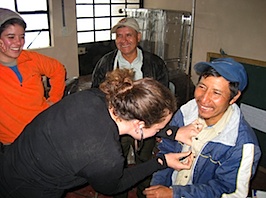 Now we are back. In true Guatemalan style, our trip was made largely ineffective by lack of communication. After we arrived, Aurelio informed us that we needed to go back a day early for a midwives’ meeting in Santa Eulalia. That left us with just one day to “work”, as Monday and now Wednesday would be filled with travel. With Tuesday came rain… a cold, soaking rain that made us pretty miserable, since we brought clothes for the Hot Steamy Jungle that we experienced last time. The locals call off everything when it rains like that; not so much because they don’t want to get wet, but because they don’t want to die in one of the mudslides that are so frequent during the rains. We just missed a HUGE one last time, largely because the elders wouldn’t go out with us in the rain despite our coaxing. So, we spent the morning unpacking and assembling medical furniture, out of sheer boredom. At one point, a single elder came by to chat, and we had fun talking to him. Here’s Emily testing out one of the new stethescopes we found, much to everyone’s delight. Now we are back. In true Guatemalan style, our trip was made largely ineffective by lack of communication. After we arrived, Aurelio informed us that we needed to go back a day early for a midwives’ meeting in Santa Eulalia. That left us with just one day to “work”, as Monday and now Wednesday would be filled with travel. With Tuesday came rain… a cold, soaking rain that made us pretty miserable, since we brought clothes for the Hot Steamy Jungle that we experienced last time. The locals call off everything when it rains like that; not so much because they don’t want to get wet, but because they don’t want to die in one of the mudslides that are so frequent during the rains. We just missed a HUGE one last time, largely because the elders wouldn’t go out with us in the rain despite our coaxing. So, we spent the morning unpacking and assembling medical furniture, out of sheer boredom. At one point, a single elder came by to chat, and we had fun talking to him. Here’s Emily testing out one of the new stethescopes we found, much to everyone’s delight.
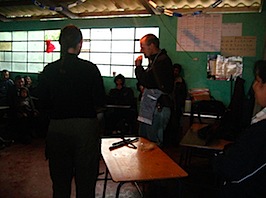 In the afternoon, we chanced the rain since our ONE lecture that didn’t get cancelled was about a 20 minute hike up the gravel road. We got there, and spoke to the bewilderd audience of the importance of handwashing to prevent things like cholera and dysentery. Not sure how much good it did, since the meeting started late (again, rain) and about 30 minutes into it, we were told to “hurry it up” since they had scheduled a teachers’ meeting immediately after. Emily was NOT amused, and we went home feeling like we got nothing accomplished. But for the backwards, ignored people of Quixabaj, just seeing white people that want to help is a good start. If we can get them used to opening up and working with us, then maybe that’s the first step in the long process of escaping the dark ages. In the afternoon, we chanced the rain since our ONE lecture that didn’t get cancelled was about a 20 minute hike up the gravel road. We got there, and spoke to the bewilderd audience of the importance of handwashing to prevent things like cholera and dysentery. Not sure how much good it did, since the meeting started late (again, rain) and about 30 minutes into it, we were told to “hurry it up” since they had scheduled a teachers’ meeting immediately after. Emily was NOT amused, and we went home feeling like we got nothing accomplished. But for the backwards, ignored people of Quixabaj, just seeing white people that want to help is a good start. If we can get them used to opening up and working with us, then maybe that’s the first step in the long process of escaping the dark ages.
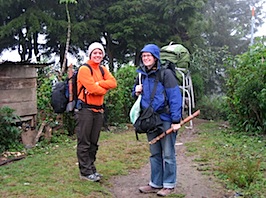 So we made the arduous trek home on Wednesday, starting at 3am (the only time a pickup leaves) and getting into Santa Eulalia at 7:00. We were pretty wiped out after hours of getting thrashed around on a muddy 4×4 trail in the dark, and not looking forward to giving a lecture to some midwives at 9:00am. But we were glad to be at least doing SOMETHING other than sitting around waiting for meetings that don’t happen. “Actually,” Aurelio said, “You probably shouldn’t go anyways. It’s just a meeting of a few of the midwives, to talk about some logistical stuff. The main meeting is in 2 weeks.” Yep, Guatemala. We threw on our packs and headed home. So we made the arduous trek home on Wednesday, starting at 3am (the only time a pickup leaves) and getting into Santa Eulalia at 7:00. We were pretty wiped out after hours of getting thrashed around on a muddy 4×4 trail in the dark, and not looking forward to giving a lecture to some midwives at 9:00am. But we were glad to be at least doing SOMETHING other than sitting around waiting for meetings that don’t happen. “Actually,” Aurelio said, “You probably shouldn’t go anyways. It’s just a meeting of a few of the midwives, to talk about some logistical stuff. The main meeting is in 2 weeks.” Yep, Guatemala. We threw on our packs and headed home.
Posted by: jfanjoy
Monday, February 2nd, 2009 at 10:50 pm
 We’ve returned to Quixabaj for our third visit, this time with Elke of StoveTeam International and a few of our coworkers from the Ministry of Health, Aurelio and Antonio Ramirez. As usual, we were late leaving Santa Eulalia. We didn’t get rolling until 11:00am, and we stopped on the outskirts of Santa Eulalia to pick up Victorina, the nurse who was traveling with us. While we were waiting for her, Emily saw a sign for a 3-for-1 cell phone credit sale, so she hopped out of the pickup to buy some airtime. She paid the guy 100q and got 300q for her phone. Then she paid the guy 50q to get me 150q. But the salesman processed the transaction wrong, and we got nothing. Then, he refused to give Emily her money back. He claimed that she must have told him the wrong phone number for the credit, but she countered that he had read it himself directly from her phone’s screen, so the fault couldn’t be hers. Witnesses standing by agreed with her, but the salesman still refused to refund the money. This turned into a 15-minute arguement, and eventually Aurelio and I got dragged into it. At one point, we even called him a thief and a liar, and warned other customers to leave the store lest they get robbed too. Some left, others didn’t. Aurelio tried to help, but got no results. I asked (rhetorically) if there were any police in this town, and Aurelio just laughed and said, “Yeah, he was just standing here a minute ago when this all started.” Nice. I considered grabbing the 50q bill from under the counter, as encouraged by one of the younger customers, but came to my senses. What would our Peace Corps bosses say if we started a fight in our hometown over about $6 US? I’d feel pretty dumb. We were both burning mad over the injustice, stupidity, complacence… but it was a lost battle. You just have to learn what you can (e.g., don’t hand over the cash until the credit is displayed on your phone) and move on. We got back in the pickup, the driver spent about 10 minutes trying to start it, then we were off for real. 12:00 noon. We’ve returned to Quixabaj for our third visit, this time with Elke of StoveTeam International and a few of our coworkers from the Ministry of Health, Aurelio and Antonio Ramirez. As usual, we were late leaving Santa Eulalia. We didn’t get rolling until 11:00am, and we stopped on the outskirts of Santa Eulalia to pick up Victorina, the nurse who was traveling with us. While we were waiting for her, Emily saw a sign for a 3-for-1 cell phone credit sale, so she hopped out of the pickup to buy some airtime. She paid the guy 100q and got 300q for her phone. Then she paid the guy 50q to get me 150q. But the salesman processed the transaction wrong, and we got nothing. Then, he refused to give Emily her money back. He claimed that she must have told him the wrong phone number for the credit, but she countered that he had read it himself directly from her phone’s screen, so the fault couldn’t be hers. Witnesses standing by agreed with her, but the salesman still refused to refund the money. This turned into a 15-minute arguement, and eventually Aurelio and I got dragged into it. At one point, we even called him a thief and a liar, and warned other customers to leave the store lest they get robbed too. Some left, others didn’t. Aurelio tried to help, but got no results. I asked (rhetorically) if there were any police in this town, and Aurelio just laughed and said, “Yeah, he was just standing here a minute ago when this all started.” Nice. I considered grabbing the 50q bill from under the counter, as encouraged by one of the younger customers, but came to my senses. What would our Peace Corps bosses say if we started a fight in our hometown over about $6 US? I’d feel pretty dumb. We were both burning mad over the injustice, stupidity, complacence… but it was a lost battle. You just have to learn what you can (e.g., don’t hand over the cash until the credit is displayed on your phone) and move on. We got back in the pickup, the driver spent about 10 minutes trying to start it, then we were off for real. 12:00 noon.
 We arrived in Quixabaj in record time (3 hours) after a standing in the back of the pickup under beautiful skies and a cool, fresh breeze. During our absence, the health center got a makeover! The fence was replaced, the debris in the yard removed, the broken window pnaes fixed, and everything repainted. Very nice. Inside, we discovered the waiting room filled with new institutional furniture still wrapped in plastic: exam tables, medicine lockers, doctors’ desks, swivel chairs. There were also boxes of medical supplies like stethescopes, kidney basins, and an autoclave. Aurelio explained that the gear was all donated by “Enel,” an Italian business that wants to install a hydroelectric power station in the valley below. I’m not sure how I feel about that: on one hand, it’s an obvious bribe to win the goodwill of the people But maybe it’s more of a thank-you? I don’t know if this power station is a good thing or not Will it destroy habitat? Will it create jobs? Will it offset carbon emissions? I don’t have enough info. In the past, Canadian mining interests used these same tactics, then basically robbed Guatemala of its mineral resources becaue the people weren’t sophisticated enough to realize what was going on until it was too late. We arrived in Quixabaj in record time (3 hours) after a standing in the back of the pickup under beautiful skies and a cool, fresh breeze. During our absence, the health center got a makeover! The fence was replaced, the debris in the yard removed, the broken window pnaes fixed, and everything repainted. Very nice. Inside, we discovered the waiting room filled with new institutional furniture still wrapped in plastic: exam tables, medicine lockers, doctors’ desks, swivel chairs. There were also boxes of medical supplies like stethescopes, kidney basins, and an autoclave. Aurelio explained that the gear was all donated by “Enel,” an Italian business that wants to install a hydroelectric power station in the valley below. I’m not sure how I feel about that: on one hand, it’s an obvious bribe to win the goodwill of the people But maybe it’s more of a thank-you? I don’t know if this power station is a good thing or not Will it destroy habitat? Will it create jobs? Will it offset carbon emissions? I don’t have enough info. In the past, Canadian mining interests used these same tactics, then basically robbed Guatemala of its mineral resources becaue the people weren’t sophisticated enough to realize what was going on until it was too late.
 So, here I am at 9:30 pm, everyone in bed because it’s after dark. About an hour ago, Aurelio came by wondering aloud how we’re gong to arrange sleeping. I can never tell in these situations if Guatemalans are incapable of planning, or are so tough and flexible that a plan is not needed. All 3 Guatemalans got into the pickup this morning with a knapsack or nothing at all, and I didn’t even stop to think that they would be “camping” just like us. Aurelio returned moments later with an armload of blankets from a nearby house. We shoved some furniture aside to make room, unwrapped a few exam tables and desks to use as makeshift beds, and threw down the blankets for the Guatemalans. The three of us Americans busted out our Therma-Rests and sleeping bags. You can never deny your culture for long, I guess. And it’s likely that we will all sleep well. So, here I am at 9:30 pm, everyone in bed because it’s after dark. About an hour ago, Aurelio came by wondering aloud how we’re gong to arrange sleeping. I can never tell in these situations if Guatemalans are incapable of planning, or are so tough and flexible that a plan is not needed. All 3 Guatemalans got into the pickup this morning with a knapsack or nothing at all, and I didn’t even stop to think that they would be “camping” just like us. Aurelio returned moments later with an armload of blankets from a nearby house. We shoved some furniture aside to make room, unwrapped a few exam tables and desks to use as makeshift beds, and threw down the blankets for the Guatemalans. The three of us Americans busted out our Therma-Rests and sleeping bags. You can never deny your culture for long, I guess. And it’s likely that we will all sleep well.
Posted by: jfanjoy
Sunday, February 1st, 2009 at 11:04 pm
OK, we’re leaving for The Jungle tomorrow. Wish us luck; I’ll give a report when we get back.
In other news, Emily and I made it into her hometown paper, the Logansport Pharos-Tribune. They ran an article titled “Answering a Call” (click to view it) and it was a pretty accurate portrayal of what we discussed with the reporter when she interviewed us over Christmas. This is kindof exciting, because the paper also asked Emily to start writing monthly columns for them during our tour in the Peace Corps. I’ll send links when it gets rolling.
Posted by: jfanjoy
|
|
|






 The feria, or county fair, rages on. It’s a week-long festival of parades, traditional dancing, horse trading, cotton-candy eating, Ferris wheel riding, drinking, and socializing. Not necessarily in that order.
The feria, or county fair, rages on. It’s a week-long festival of parades, traditional dancing, horse trading, cotton-candy eating, Ferris wheel riding, drinking, and socializing. Not necessarily in that order.
























